Home / Gas boilers
Back
Published: 01/15/2020
Reading time: 4 min
0
3848
A gas boiler is a heat source for heating systems. This device is designed to convert the energy obtained from gas combustion into heat to heat the water coolant of the heating system.
The design of a gas boiler ensures the implementation of the main task - the efficiency and reliability of autonomous heat supply systems, with minimal participation from the user.
- 1 How gas boilers work 1.1 Double-circuit boiler
- 1.2 Gas burner design for the boiler
- 2.1 How a condensing boiler works
What is a boiler piping and what does it consist of?
The piping is a set of heating equipment that ensures the transportation of heated water to the radiators and the trouble-free operation of the heater itself.
On the one hand, it helps to evenly distribute heat throughout the rooms of the house, and on the other hand, it increases the reliability of the entire heating system, protecting the boiler from overheating and excessive fuel consumption.
Also, piping the heating apparatus means calculating the parameters of all elements of the intra-house heating network and their installation. The heating system must not only work reliably, but also correctly. A large number of additional devices and complex wiring can seriously reduce its effectiveness. Everything must be done correctly.
Correct piping increases the efficiency of the water heater and the reliability of its operation.
There are simply no optimal and ready-made heating system options for all buildings without exception. To achieve maximum efficiency from a particular boiler, you have to prepare an internal heating network project for each house individually. But there is a certain set of standard rules and a list of standard equipment.
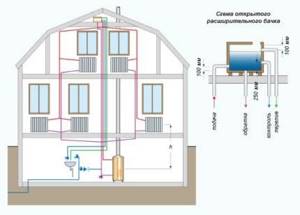
In the simplest piping scheme for a heating boiler with gravitational movement of the coolant, there is a minimum of shut-off and control devices (+)
Depending on the type of fuel used, the size of the house, the model of the heater and its location, polypropylene piping is done according to various schemes.
But all of them contain:
- Boiler (single-circuit or double-circuit).
- Expansion tank . Hydraulic with a membrane or a regular tank, depending on the type of heating system.
- Polypropylene pipes and fittings.
- Batteries (cast iron, steel, aluminum, bimetallic).
- Bypasses (pipeline sections that allow individual devices to be disconnected from the circuit). Recommended for all types of networks, but not always used in simple flow-through circuits.
According to the principle of coolant movement, heating circuits are divided into systems with natural (gravitational) and artificial (pumping or forced) circulation.
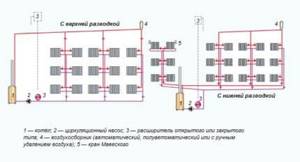
The circulation pump is an essential component of forced-type heating. It is needed to stimulate the movement of the coolant (+)
In a forced-type heating network, the above set is supplemented by:
- Mayevsky crane.
- Circulation pump.
In a circuit where coolant is supplied to each device through the supply and return lines designated specifically for it, a collector - a distribution device - must be included.
In heating circuits that require mandatory adjustment of the qualitative and quantitative characteristics of the circulating liquid or steam, monitoring devices are built in:
- Pressure gauge.
- Thermostat.
- Hydraulic arrow, if there is a need for pressure equalization.
In a system with forced circulation of coolant, an expansion tank with a membrane is installed to maintain a given pressure in it. And in its gravitational analogue, an ordinary open tank without any inserts inside will be sufficient.

The expansion tank of systems with natural water movement comes into contact with the external environment, which is why they can become saturated with air. To prevent this phenomenon, the systems are supplemented with an air circuit that collects and discharges air
The expansion tank of the simplest heating system with a natural principle of movement is an ordinary container with a pair of pipes screwed or welded into it. One of them is a supply pipe, the second is a signal pipe, indicating that the container is filled with water that expanded when heated. In a more complex version of the tank, four pipes are screwed in.
When the volume of coolant increases above the required norm, the excess is simply discharged through the signal pipe. In the future, the coolant will expand in the same way and take on the same volume, but there will be no overflow into the signal pipe. By analogy, the air is discharged spontaneously, therefore there is no need to install Mayevsky cranes.

A control and safety group consisting of various sensors, regulators and emergency valves is built between the boiler and polypropylene pipes
Circulation pumps are not used in circuits based on the natural principle of coolant movement. In such a system, water moves under the influence of gravity.
It does not require additional pressure blowers. On the one hand, this increases the reliability of heating (there is simply nothing to break), and on the other hand, it reduces the quality of heating of the distant rooms in the house (the coolant reaches the outermost rooms already cooled down).
The intricacies of installing a heating system made of polypropylene pipes are described in detail in one of the popular articles posted on our website.
Choosing a boiler
How to do the correct installation of cottage heating so that all costs are justified and the equipment heats the house for as long as possible? First, you need to decide how much money you can spend on the device - this will determine which boilers of what price category to consider. Of course, usually the more expensive the device, the better quality it is.
Next, it is important to assess what areas the unit will need to heat. A floor-standing boiler is a fairly powerful unit; it is quite enough to heat a two-story cottage. But if the areas are extremely large, then you should buy an installation of this type, which can be combined into a kind of cascade of devices. The required power can be calculated using the formula 1 kW = 10 m2 . In this case, about 15-20% is added to the result - this is a reserve of power for heating water for domestic needs.

Gas double-circuit floor-standing boiler
Attention! When calculating the boiler power, it is necessary to take into account the number of windows, doors, number of floors in the building, ceiling height and other parameters of the room that affect its rate of heating and cooling. If the house is poorly insulated, then purchase a unit with more power.
Depending on the room where the boiler will be installed, the type of combustion chamber is also chosen - if it is not possible to ensure good exhaust removal, then it is better to buy a unit with a closed combustion chamber.
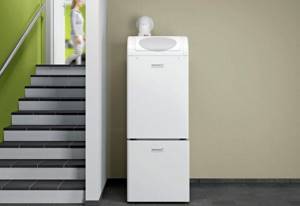
Floor-standing double-circuit boiler for home
When choosing a boiler, you should pay attention to the following parameters:
- efficiency;
- fuel consumption - usually indicated in documents and installation instructions, depends on power;
- DHW throughput - demonstrates how much water the device will heat in one hour (run-up approximately 2.5-17 l/min);
- water heating temperature (usually +55 degrees);
- temperature in the heating circuit (about +90 degrees);
- degree of automation;
- water pressure in the circuit (1-10 bar);
- possibility of switching to another type of fuel;
- expansion tank volumes (17 l or more);
- various additional functions - for example, thermostats.

Boiler thermostat
If you plan to purchase a gas boiler, then a sensor is also installed in the room where it will be installed, which will give a signal in the event of a gas leak. It is better to purchase this sensor immediately.
Calculation of the expansion tank online calculator, the total volume of the heating system
Prices for a double-circuit floor-standing boiler
double-circuit floor-standing boiler
Polypropylene pipes in heating systems
Fittings and pipes made of polypropylene (PPR) are popular due to their low cost and ease of installation. They are not subject to corrosion, have smooth internal walls and serve no less than the 50 years declared by the manufacturer.
There are several types of these pipe products, which differ in technical characteristics and purpose.
In the construction of heating systems, as well as in the installation of hot water supply circuits similar to them in operational parameters, the following is used:
- Pipes marked PN 25. Products with reinforcement made of aluminum foil. Used in systems with nominal pressure up to 2.5 MPa. Operating temperature limit +95º C.
- Pipes marked PN 20. Reinforced version used in DHW branches of double-circuit heating boilers. They will work for the period stated by the manufacturer if the coolant temperature is not higher than +80º C and the pressure is not higher than 2 MPa.
- Pipes marked PN 10. Thin-walled polymer products. They are used if the boiler supplies coolant to the water heated floor system. Operating temperature not higher than +45º C, nominal pressure up to 1 MPa.
Polymer pipes are suitable for all known installation methods: open and hidden. But this material has a high coefficient of thermal expansion. When heated, such products begin to slightly increase in length. This effect is called thermal linear expansion and must be taken into account when constructing pipelines.

The boiler should be tied with polypropylene pipes, which are marked as operating class 5, operating pressure of 4–6 atmospheres and nominal pressure PN of 25 and above
To prevent destruction of polypropylene heating pipelines, compensation loops can be installed. But it’s easier to take multilayer pipes, the reinforcement in which is specifically designed to compensate for this stretching. A layer of foil inside PN 25 polypropylene pipes reduces their thermal elongation by half, and fiberglass by five times.
Installation of an autonomous heating system in an apartment step by step
Coordination of all planned alterations with the relevant organizations. Notifying neighbors that work is planned at a certain time. The time frame will need to be agreed upon in advance, since such repair work is always accompanied by loud noise. You don't want conflicts with your neighbors. If gas heating is planned, then a special chimney must be equipped in advance. If the device is electric, you will have to install a separate line of appropriate power in advance to power it. Where the heating device is installed, the floor finishing must be made of non-combustible material. According to the standards, a certain distance from walls and furnishings is provided. The next step will be to mark the boiler, pipes and radiators according to the prepared project. If the system operates with a gas boiler, you will need to install a gas flow meter. This is not required for electrical equipment. Buy and deliver the boiler to the installation site. While still in the store, check it for completeness, as well as for the absence of visible defects and damage. Even minor scratches on the body may indicate that the boiler was either transported incorrectly or was dropped by movers. And all this can lead to breakdowns that are not noticeable upon purchase and can only be discovered during operation. Installation of gas equipment
Particular attention should be paid to leveling the boiler horizontally and vertically; Only correct installation guarantees stable operation of such a heating device. Laying heating pipes according to the project diagram. As a rule, circuits with forced coolant circulation are used
Therefore, if a pump is not provided inside the gas boiler, then it will need to be purchased and installed. Boiler piping - connecting equipment to water supply and gas supply pipes. And also an exit to the chimney. Connecting heating radiators. If necessary, purchase and installation of new heating elements. Test launch of an autonomous heating system. It is necessary in order to find and eliminate possible leaks in joints, and check the performance of gas or electrical equipment, as well as the efficiency of the entire system.

An autonomous heating system is profitable and efficient. However, we should not forget that autonomous heating in an apartment with your own hands is an unsafe undertaking. Moreover, if you plan to use gas equipment, then only specialists should install it.
In general, we answered the question of whether it is possible to install autonomous heating in an apartment: not only is it possible, but it is often necessary. After all, utility bills are only growing every year, and heating bills are the highest.
Features of installation of PPR pipelines
When piping a boiler, polypropylene pipes and fittings are connected mainly by cold or hot welding; when connecting to metal pipelines, threaded connections are used. Screwing on is much more convenient, but because of them, assembling the system will cost significantly more.
True, if you want to connect a polypropylene pipeline to a metal counterpart, you cannot do without threaded fittings.

An extensive line of fittings is produced to form linear and nodal connections of polypropylene pipes
“Hot” welding is done with a special apparatus (soldering iron, “iron”). The pipes are heated using a suitable nozzle to a melting temperature of 260 degrees, and then the parts with softened edges are pressed against each other. The result is a reliable and monolithic connection.
Before welding, the foil of reinforced pipes must be cleaned. Otherwise, it will interfere with the connection of polymer products, making the seam fragile. With fiberglass, these unnecessary steps will not be required. It melts easily along with the plastic.

PPR soldering technology is extremely simple, all work can be done with your own hands (+)
Cold welding involves the use of a specialized adhesive composition. In recent years, this method has rarely been used, because the result is not reliable enough.
Flue gas removal
When piping a floor-standing boiler, special attention must be paid to exactly how combustion products will be removed from the equipment. According to the law, the removal of such gases must be ensured only through a separate chimney, the end of which goes to the street. The cross-section of such a chimney should not be smaller than the cross-section of the boiler pipe. Pipes must run vertically, have no ledges, and horizontal sections are not allowed.

Scheme of a coaxial chimney for gas boilers.
If necessary, you can make a slight slope of the pipe, which is equal to 30 degrees, but only in a section of up to 1 m.
The floor-standing boiler is connected to the pipe using a special element; the total length for the entire section of the chimney should be up to 3 m, and the slope of the pipe is allowed up to 0.01 m towards the boiler itself. The number of turns for the smoke exhaust device should not be more than 3. This rule is dictated by security considerations. A little below the connection between the pipe and the boiler, an inspection hatch should be provided. When wiring, be sure to ensure that the pipe is protected as much as possible. Combustible finishing materials should not come close to it.
Connecting the boiler to power supplies
If the boiler runs on gas fuel, then it needs to be supplied with gas. For main gas supply, this must be done by a gas service employee. If the heating is from cylinders, you need to conclude a lease agreement with Gaztekhnadzor, and entrust the installation to a company that has permission for this type of work. All work related to gas is potentially dangerous and this is not the moment when you should save money and do the work yourself.

1. Heating supply. 2. Hot water for domestic needs. 3. Gas. 4. Cold water to the DHW circuit. 5. Heating return

When using bottled gas, a reducer must be used that combines a group of cylinders
The electric boiler must be connected to the network. The boiler and terminal box must be grounded; all connections are made with copper wiring with a cross-section no less than that specified in the technical data sheet for the equipment.
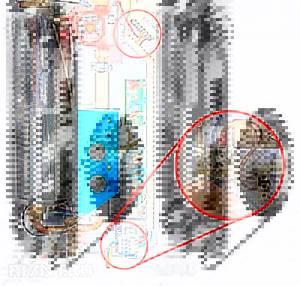
A solid fuel boiler is always autonomous and only requires the connection of heating and hot water supply pipes. Connections to electrical power circuits require only automatic control units, if they are involved.
Requirements for boiler installation
The norms and rules that ensure trouble-free operation of boilers vary for each type of heater. The most stringent requirements are imposed on units operating on gaseous fuel. This is associated with the risk of depressurization and subsequent explosion of the gas-air mixture. When installing heating in a private home, the homeowner should be guided by several documents:
- SNiP 41-01-2003 “Heating, ventilation and air conditioning”;
- SNiP 21-01-97 “Fire safety of buildings and structures”;
- SNiP 2.04.01-85 “Internal water supply and sewerage of buildings.”
To approve the project, the homeowner submits an application to the local utility service, which specifies the type of equipment to be installed. After considering the request, the regulatory authority agrees on the technical conditions that must be fully implemented when installing the boiler and heating system. The next stage is drawing up and agreeing on the project. The processing time for the latter depends on the complexity and can range from several weeks to 3 months. If the project has not received approval, then the applicant is given a list of actions that need to be performed to obtain a positive conclusion.
Elements of piping of a floor-standing boiler
Let's consider what elements the piping of a floor-standing gas heating boiler may include.
Expansion tank
A membrane expansion tank is necessary to compensate for the increased volume of water or antifreeze when they are heated. This element is divided by a membrane into two parts, one of them is filled with air or nitrogen. As the volume of coolant increases, the gas is compressed, so the pressure in the heat exchanger does not increase significantly.
Note! The volume of the expansion tank must be at least 10% of the amount of coolant.
Safety valve
The purpose of the safety valve is to relieve excess coolant when there is a large increase in pressure in the circuit in order to prevent rupture of heating system pipes. Excess liquid is discharged through the drainage tube into the sewer system. If the valve operates frequently, this indicates that the expansion tank is not of sufficient size.
Pressure gauge
A pressure gauge is needed to monitor the operating pressure in the circuit. Sometimes a thermomanometer is used instead, which measures not only pressure, but also temperature. The scale of such a device should reach at least 4 atmospheres.

Air vent
The air vent is designed to release air masses that remain after draining the coolant into the environment. The remaining air creates noise and acts as an obstacle to the normal circulation of the coolant.
Circulation pump
The pump circulates the coolant forcibly. Its power can be changed, thereby regulating the speed of fluid flow in the heat exchanger.
Indirect heating boiler
A boiler is necessary to provide hot water in the required volume. It is a heat-insulating tank in which heated water is stored.
Hydroarrow
A hydraulic arrow is a container with pipes to which you can connect several circuits that combine supply and return. This element allows you to connect pipes in which the liquid has different circulation rates and temperatures.
Coarse filter
This element is a reservoir with a filter mesh to purify water from large debris. The filter protects the heat exchanger tube from clogging.

Pipes
Many people are interested in the question of what pipes can be used for piping a floor-standing gas boiler. The temperature in the circuit usually does not exceed 80°C, and in the underfloor heating system it does not exceed 35°C. The pressure is at the level of 1-2.5 kgf/cm2. When the pump is stopped, boiling of the coolant is prevented, since after a few seconds the burner stops working and the flame goes out. Based on the existing operating conditions, polymer and metal-polymer pipes, the cost of which is much lower than durable copper or galvanized analogues, are quite suitable for piping a floor-standing gas heating boiler.
Which floor-standing gas boilers are better - with a built-in or indirect boiler? Read here the general requirements for the installation and connection of gas boilers. How to connect a wall-mounted gas boiler?
Gas-burner
The burner's task is to mix the natural gas entering it with air, thereby preparing a fuel-air mixture. It is then distributed over several nozzles, where it burns.
Gas burners are:
There are a great variety of heating boilers on the market. Read on our website what are the advantages of the Beretta gas boiler over other manufacturers.
Read about the advantages of double-circuit heating boilers here.
Instructions for making a diesel burner are presented here.
Atmospheric
Air is sucked into the gas stream due to the low pressure present in it (according to Bernoulli's law, the pressure in a moving stream decreases in proportion to its speed).
Advantages:
- low cost;
- simplicity of design;
- silent operation.
But at the same time, the combustion chamber has to be made open, and the burner power is limited.
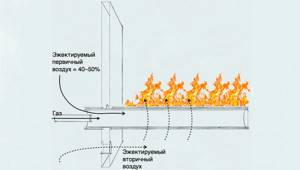
Operating principle of an atmospheric burner
Supercharged
A more complex structure into which air is pumped by a fan. With advantages and disadvantages, the picture is the opposite: the burner is expensive and noisy, but the combustion chamber is closed and there are no restrictions on power.

Boilers with forced-air burners and, accordingly, closed combustion chambers have another advantage: since the smoke is forced out, they can be equipped with a horizontal pipe that goes outside through the wall.
Usually a coaxial pipe is used, the cross-section of which is divided into two parts: combustion products are removed along the inner one, and air enters the firebox through the outer one.
In addition, gas burners are divided into the following types:
- Single-stage: they have a fixed heating output and operate in start-stop mode. They are cheap, but the elements of a boiler with such a burner operate under conditions of significant and sudden temperature changes, which is why their service life is reduced.
- Two-stage: can operate in two modes: with maximum power and with 40 percent. The intermediate stage ensures a smooth start of the burner and allows it to be turned off less often, so that ultimately the boiler operating mode becomes more gentle.
- Modulating: the most expensive burners, the heating output of which can be smoothly changed in the range from 10% to 100%. Instead of a “start-stop” mode, such a burner operates constantly at the required power, so that the boiler elements are not subject to thermal overload, and temperature changes are completely eliminated. The boiler, accordingly, lasts longer. In addition, the modulating burner optimizes fuel consumption, so that the heat generator becomes even more economical.
The burner is equipped with one of two types of ignition device:
- Piezo ignition: when starting the boiler, the user presses the piezo-mechanism button once, from the spark of which the pilot light or wick (pilot burner) lights up. Subsequently, the main burner lights up from the igniter.
- Electronic. The device generates a spark independently, without user intervention.
In the second case, the gas burner is ignited directly, so that a pilot light is not required (gas consumption is reduced).
Gas boiler piping
Modern gas boilers have good automation that controls all parameters of the equipment’s operation: gas pressure, the presence of a flame on the burner, the pressure level and temperature of the coolant in the heating system. There is even automation that can adjust work to weather data. In addition, wall-mounted gas boilers in most cases contain such necessary devices as:
- safety group (pressure gauge, air bleed valve, emergency valve);
- expansion tank;
- circulation pump.
In wall-mounted gas boilers, an expansion membrane tank and a safety group are already installed

The parameters of all these devices are indicated in the technical data of gas boilers. When choosing a model, you need to pay attention to them and choose a model not only by power, but also by the volume of the expansion tank and the maximum volume of coolant.
Wiring diagram for a wall-mounted gas boiler
In the simplest case, the boiler piping contains only shut-off valves at the entrance to the boiler - so that repair work can be carried out if necessary. A dirt filter is also installed on the return pipeline coming from the heating system to remove possible contaminants. That's all the harness.
An example of piping a wall-mounted gas boiler (double-circuit)

In the photo above there are corner ball valves, but this, as you understand, is not necessary - it is quite possible to install ordinary models, and turn the pipes closer to the wall using corners. Also note that there are taps on both sides of the sump tank - this is so that you can remove it and clean it without draining the system.
In the case of connecting a single-circuit wall-mounted gas boiler, everything is even simpler - only gas is supplied (gas workers connect), hot water supply to the radiators or water heated floor and return from them.
Wiring diagrams for floor-standing gas boilers
Floor-standing models of gas heating boilers are also equipped with automation, but do not have a safety group, an expansion tank, or a circulation pump. All these devices have to be installed additionally. Because of this, the wiring diagram looks a little more complicated.
Wiring diagrams for a floor-standing gas boiler
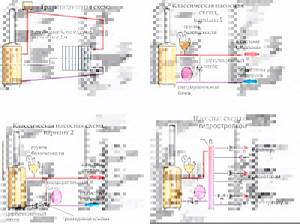
On two classical boiler piping schemes, an additional jumper is installed. This is the so-called “anti-condensation” loop. It is needed in large systems; if the return water temperature is too low, it can cause condensation. To eliminate this phenomenon, this jumper is installed. With its help, hot water from the supply is mixed into the return pipe, raising the temperature above the dew point (usually 40°C). There are two main ways to implement it:
- with installation of a circulation pump with an external temperature sensor in the jumper (and the photo is at the top right);
- using a three-way valve (pictured below left).
In a scheme with a circulation pump on a jumper (condensation pump), it is made with a pipe of a smaller diameter than the mains. The sensor is attached to the return pipe. When the temperature drops below the set value, the pump power circuit is turned on and hot water is added. When the temperature rises above the threshold, the pump turns off. The second pump is the heating system itself; it works all the time while the boiler is running.
In the second scheme with a three-way valve, it opens the addition of hot water when the temperature drops (set on the valve). In this case, the pump is located in the return pipeline.
Principle of operation
The operating principle of a gas heating boiler is quite simple. Through the return pipeline from the heating network inside the house, cooled water is supplied by a circulation pump to the input of the heating circuit heat exchanger.
At low coolant temperatures, an electromechanical valve opens, supplying fuel to the injector. The igniter ignites the gas and the combustion process begins. The boiler constantly operates on the heating circuit.
The DHW circuit begins to function when the tap on the mixer is opened. This thermal scheme of the boiler operation in the summer makes it similar to the operation of a conventional gas water heater.
How does a condensing boiler work?
The name “condensing” boiler units was acquired due to the fact that they implement a technology for obtaining additional thermal energy by modifying the aggregate state of condensate from steam located in the flue gases.

Operating principle of a condensing boiler
During the combustion of natural gas in a condensing gas boiler, water vapor is created, which in traditional units evaporates and is released into the atmosphere through a chimney.
Experts have developed an additional device in the boiler - a water economizer, in which steam in the flue gases turns into condensate, while releasing additional heat, which is transferred to the coolant in the economizer.
The temperature at which the condensate is converted is called the dew point of +55 C, and the technological process is called condensation. This temperature corresponds to the parameters of the return network water entering the boiler from the heating system. If it is more than +60 C, then the condensing boiler will work like a traditional device with low efficiency.
In addition, condensate creates a very aggressive environment containing acids. Therefore, its collection and disposal will require a special neutralization system, which the liquid must undergo before it can be discharged into the city sewer.

Condensing boiler. Photo source: allbuildingtips.com
In general, a convection gas boiler is an expensive device, however, fuel savings of up to 20% allow it to pay for itself within five years.
The principle of operation of a double-circuit gas boiler
The operating principle of a double-circuit boiler unit is designed for 2 thermal modes:
- heating;
- DHW.
In heating mode, the operation of the boiler is practically no different from a single-boiler boiler. Starting the burner involves a fairly long start-up period in order to increase the temperature in the heating circuit to operating levels. When the main mode is reached, the flow of fuel to the burner stops.
The internal air temperature sensor allows you to automatically regulate the temperature and sends a signal to open the gas when the permissible level decreases.
Modern double-circuit Baksi boilers, in addition to an internal temperature sensor, are equipped with a special weather-dependent automatic system that regulates the operation of the boiler based on the outside air temperature outside the building window. The burner increases the temperature of the heating water, the circulation of which through the pipelines of the heating system is ensured by a circulation pump. A three-way valve built into the system switches the movement of coolant through the heating circuit or into the DHW system.
Today's double-circuit heating boilers are equipped with automatic control and safety systems. In emergency situations, flame and draft sensors are capable of shutting off the gas supply to the boiler through an electromagnetic valve, thereby preventing the creation of an increased concentration of gas in the boiler room.
This mechanism not only shuts off the gas supply, but also informs others about the danger using sound and light alarms, and also starts exhaust ventilation to reduce the content of methane and carbon monoxide in the air.
Solid fuel boiler piping
Any owner of a TT boiler knows that during the active combustion phase a lot of heat is released. Over time, experience comes - when and how exactly to close the damper, for what period of time, etc. But if you get a little distracted, the water in the system will overheat and may even boil. To prevent this phenomenon, the boiler piping without automation must contain several devices that prevent the system from boiling. Only in this case can wiring around the house be done with polymer pipes. Otherwise, sooner or later, the overheated coolant will soften the material, the pipes will burst with all the ensuing consequences. Therefore, piping a solid fuel boiler, in addition to the traditional elements - a safety group, an expansion tank and a circulation pump - contains a significant number of additional devices and usually requires quite a lot of money.
Requirements for boilers
Floor standing units are great for heating large homes. Installing this device often requires distributing the coolant over several rooms and floors. To choose the right equipment, you need to mentally imagine the location of the pipes. This will help you avoid making a mistake with your purchase.
Models of this type have a significant mass, so the device needs to be equipped with a solid base. It is not necessary to fill a wooden floor with concrete; you can cover it with sheets of galvanized iron.
The following requirements apply to boilers:
- The presence of a mechanism for adjusting power.
- Elements of protection and control.
- Economical fuel consumption.
- Small dimensions and acceptable weight.
- Installation and installation must be carried out efficiently and in accordance with all rules. It is recommended to entrust this work to a specialist.
- The unit must be connected to a chimney; if it is not equipped with a forced draft, you need to check the draft yourself.
Electric and diesel heat generators
Connecting a diesel fuel boiler to the radiator system is identical to piping gas-using installations. Reason: a diesel unit operates on a similar principle - an electronically controlled burner heats the heat exchanger with a flame, maintaining the set coolant temperature.
Clarification. The recommendation does not apply to heaters equipped with a homemade burner device that burns diesel and waste oil, for example, a Babington flare burner. An individual approach is needed here.

Electric boilers, in which the water is heated by heating elements, an induction core, or through the electrolysis of salts, are also connected directly to the heating. Automation located in an electrical cabinet connected to the network according to the electrical diagram provided is responsible for maintaining temperature and safety. Other connection options are shown in a separate publication on the installation of electric heating boilers.
Wall-mounted mini-boiler rooms equipped with tubular heaters are intended only for closed heating systems. To work with gravity wiring, you will need an electrode or induction unit, which is tied according to the standard scheme:

If you look at it, there is no need for a bypass here - the boiler will not work without electricity either
Types of boilers for heating a private house
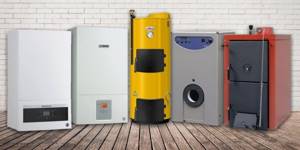
At the heating system design stage, the homeowner may be faced with a seeming variety of boilers. Selecting the right unit will simplify the availability of energy resources. Manufacturers produce 4 types of heaters: electric, gas, solid and liquid fuel boilers. The latter modification is rarely used due to the high price of fuel (mainly diesel).
The most common boilers are those using natural gas. They operate in manual or automatic mode and do not require constant monitoring. Even budget models are able to independently maintain the temperature at a given level. A significant limitation in using a gas boiler is the availability of fuel. If there is no gas pipeline connected to the house, the owner will have to look for another source of heat.
Electric boilers can become an alternative to gas ones. However, the cost of electricity is higher compared to blue fuel. The heaters also operate automatically, they are silent and take up little space, which eliminates the need for a separate room for installation of equipment. In addition, they do not require the construction of a chimney.

In the absence of access to a gas pipe and unwillingness to pay electricity bills, homeowners install boilers that burn solid fuel. You can burn wood, coal, and pellets in them. However, such heaters require constant supervision: as the fuel burns out, it must be periodically added and the ash must be removed. In addition, solid fuel boilers are installed in a separate room so that soot does not settle in living rooms.
For your information!
Some manufacturers produce automatic solid fuel boilers with ultra-long burning. They independently regulate the temperature of the coolant, and fuel enters them from the bunker, which ensures continuous operation of the unit.
Systems with two boilers
If it is necessary to organize heating of the coolant in a closed circuit from two heat generators, use the parallel connection principle. Let us explain the algorithm for the joint operation of two boilers - electric and solid fuel (the piping is shown in the figure):
- The main heat source is a TT boiler, connected in the standard way through a three-way valve. To prevent flows from looping in the other direction, a check valve is installed on each branch.
- When a stack of firewood burns out, the air in the house begins to cool. The temperature drop is detected by the room thermostat and starts the electric boiler with a pump.
- A decrease in the temperature in the supply line of the TT boiler to 50-55 °C causes the overhead thermostat to turn off the circulation pump of the solid fuel circuit.
- After the next loading of firewood, the supply pipe heats up, the temperature sensor starts the pump and heating priority returns to the solid fuel unit. The room thermostat no longer turns on the electric boiler because the air temperature does not drop.

An important point. The above-described piping option can be used for any pair of boilers. When installing a wall heater, a second pump is not installed.
Two heat generators, for example, gas and electric, are easily connected through a heat accumulator. The turning on and stopping of both boilers can be organized in various ways - by the temperature of the water in the tank, by time using a timer. Check valves are not needed here.
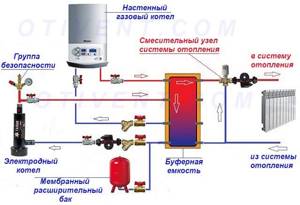
If it is necessary to connect 2-3 units of thermal power equipment with several heating circuits, it is better to assemble a diagram of primary / secondary rings. The principle is as follows: all heat sources and consumers with their pumps are connected to a common ring made of a pipe of increased diameter Ø26...40 mm (depending on the number of branches). Circulation inside the ring is provided by a separate pump.

The order of equipment installation matters: the water heater receives the hottest coolant, followed by the batteries, and finally the TP (along the water flow)
In a system with natural coolant movement, two boilers are also combined in parallel. Here it is important to withstand slopes of pipes Ø40...50 mm, and also to avoid sharp turns, using bends at an angle of 45° or bends with a large bend radius.

The water diverges along two parallel branches with boilers. But the unit that is currently turned on will make it move by gravity; the pump starts at the request of the owner
Advice. A series connection of 2 units has a right to life, but it is better not to use such a connection. Water heated in the first boiler will pass through the cold heat exchanger of the second and will certainly lose some of the heat.
Watch this video on YouTube
Why install two boilers at once?
The role of the leader in the gas + electric combination is usually performed by a gas unit. This is logical, if only because of the lower cost of the fuel used in the supply. But the word “save” was mentioned above, and it is not clear what the cost reduction is.
The fact is that in many regions the electricity tariff is based on the day/night system. In some cases, it turns out, at least a little, but more economical than paying for gas. The difference is doubtful, but it can serve as an additional reason to add arguments for the double connective.
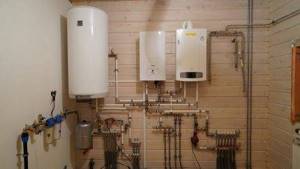
Installing an electric boiler in conjunction with a gas boiler can play a backup or additional role in the overall organization of heat supply. When choosing equipment power, you should focus specifically on the purpose of its use.
Of course, this is not such a compelling reason to immediately design a heating system with 2 boilers. The main advantages of the circuit are power amplification and uninterrupted operation. When choosing and installing a heat generator, you must clearly understand that any device and fuel supply are not eternal.
The power supply is turned off, the gas line may be blocked due to a leak, the voltage in the network will drop, or a simple breakdown of the unit itself will occur. In this case, you risk being left without heat and hot water during the cold season.

To ensure uninterrupted operation of heating equipment or increase the power of the system as a whole, it is possible to allow 2 boilers operating on different fuels to operate at once
This is called connecting an additional (to enhance power) or backup power source, depending on the purposes and situations that arise.
Natural circulation
The gravity system is characterized by complete energy independence: its operation is ensured by atmospheric pressure. Instead of a bulky safety group in the piping of a single-circuit boiler, an expansion tank is sufficient. For bottling, it is advisable to install a vent in front of the boiler heat exchanger: this will make it possible to completely drain the water into the sewer or drainage well. Typically, such a need arises in the event of a long departure, or when the gas supply is cut off. As a result, the system is protected from defrosting.
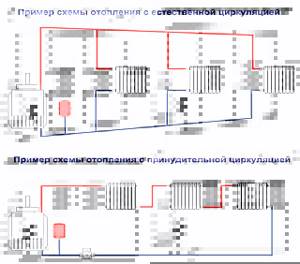
The individual components of the system are located as follows:
- It is recommended to install the tank above all other elements.
- The bottling located immediately after the boiler is positioned in the vertical direction (a small angle is allowed). Thanks to the acceleration section, the water heated in the heat exchanger rises to the top filling point.
- It is important to maintain a constant slope when laying the bottling after the tank. As a result, the cooling water will return by gravity: in this case, air bubbles will be able to escape inside the expansion tank.
- The boiler must be lowered as low as possible. The best place to place the heater is in a pit, basement or basement. Due to the difference in height between the heat exchanger and heating devices, the proper level of hydraulic pressure is ensured, ensuring water circulation in the circuit.

Some features of arranging an inertial heating system:
- For the internal filling diameter, an indicator of 32 mm is selected. If plastic or metal-plastic pipes are used, then the outer diameter is 40 mm. Thanks to the large cross-section, compensation is achieved for the minimum hydraulic pressure due to which the coolant moves.
- The gravity system sometimes includes a pump: however, this does not mean that the circuit loses its energy independence. In this case, the pump is mounted not in the filling gap, but parallel to it. To connect individual taps, a ball-type check valve is used, which is characterized by very low hydraulic resistance. A ball valve is also installed. If the pump stops, the bypass is shut off, which preserves the functionality of the natural circulation circuit.
Methods for laying heating pipes in the house
Regardless of the pipeline layout, the laying of heating pipes can be open or closed. An open pattern is most often laid out along wall panels, for example, along a baseboard. But the closed one can be performed inside walls and floors. The choice depends on the owner’s requirements for the aesthetics of the room and the skill of the craftsman.
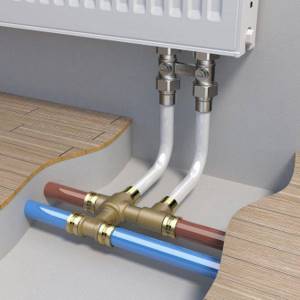
Now, once and for all, without any registrations or SMS, you can click on the active link and continue to enjoy the game and place bets on your favorite team in a convenient mobile application.
Types of fittings and diameter of metal-plastic heating pipes
If the design technology of the heating system is not violated, then the installation method does not affect the performance and reliability of the system.
But there are a number of points to consider:
- The installation technology depends on the pipe material. Steel parts have the property of minimal thermal expansion, therefore it is possible to hide the pipeline in the walls - the risk of rupture and deformation is reduced to zero
- When heated, metal-plastic parts expand more than steel elements. For safe operation, pipes must be protected with metal sleeves with an internal diameter larger than the cross-section of the heating pipe. Insulation allows you to level out the risk of deformation during linear expansion of the pipeline and reduces heat loss.
Open installation is carried out by securing the main line elements to the wall with special clips. Let's look at both installation technologies in more detail.
Hidden gasket
The technology involves hiding pipelines in walls, floors or under the ceiling (in a sheathed structure). The easiest way to create a hidden heating scheme is during the construction or major renovation of a house.
Rules for arranging hidden gaskets:
- integrity of communications - circuits without an abundance of connections are less at risk of leakage;
- areas of detachable connections should be easily accessible for inspection and renovation;
- it is strictly forbidden to hide the contours of old pipes;
- it is necessary to draw up a technical plan for the pipeline so as not to damage the system during subsequent repair work.
Open gasket

The scheme is considered the simplest and most accessible for independent implementation. With this technology, the highway remains visible.
Advantages of open wiring:
Decorative paint, box and contours for heating pipes
- Simplicity, efficiency. The work is completed quickly, there is no need for lengthy preparatory and finishing work.
- Availability. All components remain visible, so if the integrity of the system is compromised, repairs will not be difficult.
- No heat loss. Since the pipeline does not come into contact with the floor or wall structures, the heat is used only to heat the room, without warming up the thickness of the finish.
An open circuit is considered a budget option. Laying is carried out without the use of insulation, insulating materials, adapters, putty and other things.
Recycling
In a parallel position to the main radiator heating circuit or a small circuit in the area from the boiler to the hydraulic switch, a low-temperature circuit is installed. It contains a bypass and a three-way thermostatic valve. Thanks to the pump, water constantly circulates inside the underfloor heating pipes.

To select new portions of hot coolant from the supply pipe when the temperature inside the return pipe drops, a three-way mixer is used. It can be replaced with a simple thermostatic valve equipped with a remote capillary-type temperature sensor or an electric thermocouple. The sensor is installed in a niche on the return line of the heated floor. The valve is activated when the coolant temperature drops.
Radiator connection of serial type
This option is possible if a condensing gas boiler is used, because The operation of classical equipment is difficult at return temperatures below +55 degrees. The fact is that a cooled heat exchanger collects condensate on its surface. Gas combustion products contain, along with water and carbon dioxide, aggressive acids. In this case, there is a real threat of destruction of steel or copper heat exchangers.
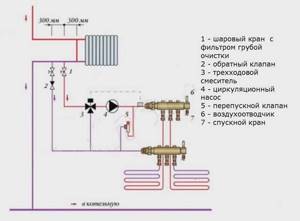
Condensing boilers have a different operating principle. A special stainless steel heat exchanger (economizer) is used to collect combustion products. As a result, additional heat transfer occurs and equipment efficiency increases. Because of this, the return pipe temperature level of +30-40 degrees is optimal. The heating system consists of two series-connected circuits - radiator and in-floor. The return pipe of the first is the supply pipe of the second.
Secondary heat exchanger
Responsible for heating water for household needs. Considering the design of a gas boiler, it is worth noting that this element is made of food-grade stainless steel plates. On one side, heated heating fluid moves through the heat exchanger, and on the other, cold water. When the heating fluid meets, it transfers its heat to cold water through a thin layer of metal. In this way, the water is heated and then flows into consumers’ taps. In this case, the heating fluid loses its temperature, entering the primary heat exchanger for subsequent heating. Such a heat exchanger has from 8 to 30 alternating layers and allows you to heat a fairly large amount of water.
Single-circuit boilers with DHW supply
To provide hot water supply, along with a safety group, a pump and an expansion tank, the piping of a single-circuit gas boiler must include an indirect heating boiler. A connection diagram for an indirect heating boiler with recirculation is possible. In this case, water is heated thanks to the coolant from the heating circuit. This leads to the appearance of two circulation circuits - a large one (through the heating system) and a small one (through the boiler). Each of them has shut-off valves, which allows you to turn them on separately. To break the supply bottling, a piping scheme is used for a single-circuit boiler with a boiler, immediately behind which a bypass with a tap is installed.
Primary heat exchanger
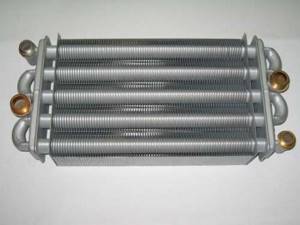
gas boiler heat exchanger
It is a determining element in the operation of the boiler; it serves to transfer heat from the fire to the heating fluid further into the heating system. The design of the heat exchanger is usually the same for all types of gas boilers from manufacturers. Externally, it is a copper pipe with heating fluid flowing inside it. Such heat exchangers are called “copper”. Since the heat exchanger is located above the burner flame, the heat from the fire heats the copper pipe, which transfers the heat to the heating fluid. It is noteworthy that copper was chosen as a metal that successfully copes with the task of retaining heat and, if necessary, losing it quite quickly, because has a high heat transfer coefficient. Also, copper does not rust quickly, due to which its service life is quite long. In addition to the copper pipe, the heat exchanger is equipped with special plates that help smoothly distribute all the heat from the fire, thereby promoting uniform heating of the heat exchanger.
Manifold wiring diagram of the heating system
If there are a large number of heating radiators located on different floors, or when connecting a “warm floor,” the best wiring diagram is a collector one. At least two collectors are installed in the boiler circuit: on the water supply - distributing, and on the “return” - collecting. The manifold is a piece of pipe into which taps with valves are inserted to allow regulation of individual groups.

Collector group

An example of connecting a heating circuit and a “warm floor” system using a manifold group
Collector wiring is also called radial, since the pipes can radiate in different directions throughout the house. This scheme is one of the most common in modern houses and is considered practical.
Method for removing combustion products
Boilers are divided into devices with natural or forced draft. Firstly, the installation of a chimney pipe is required. Secondly, combustion products are removed in a forced manner - thanks to a fan built into the chimney pipe.
Gas boilers operating on natural draft are also called devices with an open combustion chamber. The oxygen necessary for gas combustion is taken from the room - this is their disadvantage. Access to outside air is required in the room with the boiler. This results in a slight draft. Lack of oxygen negatively affects health.
Some boilers are equipped with a coaxial chimney. They are called gas boilers with a closed combustion chamber.
Combustion products are discharged through a coaxial chimney, called a “pipe-in-pipe”. These are two pipes of different diameters inserted into one another. Gas combustion products are removed through a pipe of smaller diameter. And fresh air from the street enters the space between the pipes, which is heated by the inner pipe. As a result, the efficiency of the boiler increases.
The advantages of such a chimney are obvious:
- Oxygen is taken from the street.
- Small chimney size, since a coaxial chimney can be installed in an external wall located next to gas equipment.
- Such a chimney can be installed anywhere in the room and be horizontal, inclined or vertical, which allows.
- Boilers with a coaxial chimney are more economical, although their cost is higher.
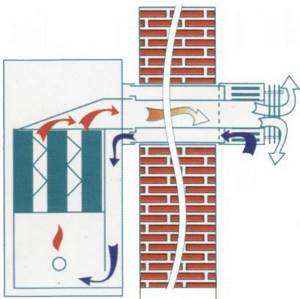
Primary-secondary rings
For boilers with a power of 50 kW or more or a group of boilers that are intended for heating and hot water supply to large houses, a primary-secondary ring scheme is used. The primary ring consists of boilers - heat generators, secondary rings - heat consumers. Moreover, consumers can be installed on the forward branch and be high-temperature, or on the reverse branch and be called low-temperature.
To ensure that there are no hydraulic distortions in the system and to separate the circuits, a hydraulic separator (arrow) is installed between the primary and secondary circulation rings. It also protects the boiler heat exchanger from hydraulic shocks.

If the house is large, then after the separator a collector (comb) is installed. For the system to work, you need to calculate the diameter of the arrow. The diameter is selected based on the maximum productivity (flow) of water and flow speed (not higher than 0.2 m/s) or as a derivative of the boiler power, taking into account the temperature gradient (recommended value Δt - 10 ° C).
Formulas for calculations:
- G—maximum flow rate, m3/h;
- w is the speed of water through the cross section of the arrow, m/s.
- P—boiler power, kW;
- w—water velocity through the cross section of the arrow, m/s;
- Δt—temperature gradient, °C.

temperature sensor
A very important element, of course, is the temperature sensor; it is used in absolutely all units and is designed to control the temperature in the room. For example, you set the temperature to 25 degrees, the boiler worked out the body for this temperature, and then left the activity. The room gets colder, and the mark drops to 24 degrees. A heat sensor reacts to this, which sends a certain signal to the unit, which again begins to function and produce heat until the room temperature is again equal to 25 degrees.
Emergency circuits
In forced circulation systems, the pumps are dependent on a power supply that may be interrupted. To prevent boiler overheating, which can damage the equipment or even lead to depressurization, boilers are equipped with emergency systems.
First option. An uninterruptible power supply or generator that will power the circulation pumps. In terms of efficiency, this method is one of the most optimal.
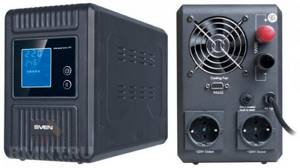
Second option. A small reserve ring is being installed, operating on the gravitational principle. When the circulation pump is turned off, a natural circulation circuit is switched on in the system, ensuring the release of heat from the coolant. The additional circuit cannot provide full heating.
Third option. During construction, two full-fledged circuits are laid, one operates on the gravitational principle, the second using pumps. Systems must have the ability to exchange heat and mass during an emergency period.
Fourth way. If the water supply is centralized, then when the pumps are turned off, cold water is supplied to the heating circuits through a special pipe with a shut-off valve (a jumper between the water supply and heating systems).
In conclusion, we suggest watching a video about the rules for calculating a single-pipe heating system for a private house.
rmnt.ru
Circulation pump operation
What the performance indicators of the circulation pump will be depends, first of all, on the power at which the boiler operates, and this device does not have much influence on the operation of the entire system. It is very important that the pipes through which the coolant circulates are made of high-quality material, for example, steel or good plastic.












